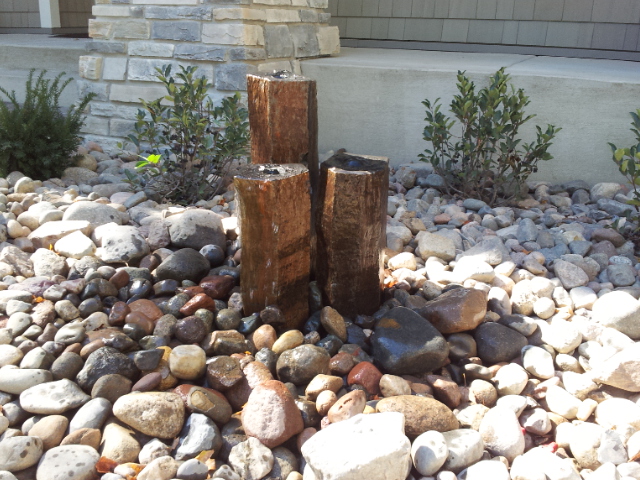Spring clean up
- Pump out the water using either your waterfall pump or a clean out pump.
Discharge this water into landscape beds or your lawn as this water is a natural fertilizer. - Clean off rock using a brush and garden hose starting from the top of the falls to the bottom of the pond, (it is okay if there is some algae left on the rocks as bacteria will break the algae down), and pump the excess water out.
- Make sure larger debris such as leaves and sticks are completely out of the pond.
- Make sure your Biofalls pad and Skimmer pad are clean and place them back into flexible PVC pipe located in your skimmer box.
- Start filling the pond can once it is filled, add Eco Starter bacteria. This will break down any heavy metals and start clarifying the water. Wait to add fish until the water temperature is at the same water temperature that the fish are stored in.
- Turn the pump on and allow the pond to circulate. This will allow the bacteria to congregate on the filter media.
- Water plants can be added to the pond mid to late May when the water temperature gets above 55 degrees.
Summer maintenance
Make sure you check the water level in the pond. Warmer weather creates more evaporation off the waterfalls and the pond itself. Adding an automatic fill valve to your skimmer box will keep a consistent water level. Below are simple solutions to help keep your pond clean and not green. There are many variables that cause algae to develop in a pond and it happens in just a short amount of time. The three biggest influences are water temperature, fish waste, and debris from trees.
To help control water temperature, water plants can be added to cover up to 1/3 of the ponds surface area to help shade the water and keep it cool. Another method is using pond dyes which dye the water blue or black. The dyes reflect the sunlight and prevent it from penetrating into deeper water.
Fish waste is a problem because it creates nitrates in the water. These same nitrates are a food source for algae to feed on. There are many water treatments that contain bacteria that are needed to break down these nitrates and eliminate the food source that algae need to survive. All these water treatments are environmentally safe for fish, pets, humans, and whatever nature may bring to your new feature. Some examples of these water treatments include: AquaClearer, SAB Extreme, EcoBlast, AlgaeFix, and Green Clean.
Debris from trees will have the same effect as fish waste by creating extra nitrates in the water. There are ways to prevent debris from getting into the pond such as using pond nets. In the fall is when we typically recommend using a pond net over the pond. During the summer months your skimmer will collect a lot of the bigger debris. It is important to check your skimmer basket often and make sure it is clean to allow for proper water flow to the pump.
Fall preparation and Winterization
- Discontinue bacteria treatment when water temperature reaches 50 degrees.
- Stop feeding fish when water temperature reaches 55 degrees.
Fish start to go dormant and their metabolism slows down. - Place netting over the pond to prevent any leaf debris from getting into the water.
- Remove any water plants and place in compost bin or inside your home over winter before the first frost.
- Disconnect the check valve and remove from skimmer. Remove the pump as well.
Be careful when disconnecting the check valve because all the water from your Biofalls and pipe are going to drain out at that connection.
Store pump and check valve in a place where they will not freeze.
Remove and clean filter pads from both the skimmer and Biofalls.
Remove fish if you’re not planning to keep them in the pond over winter.
Transfer some water from your pond to a holding tank.
Use a small aerator in the holding tank to provide oxygen for fish survival
Winterizing fish in your pond
The depth of your pond should be a minimum of 2 ½’ deep. Pond heaters are required to keep an open hole of water to allow carbon dioxide to escape.
Aerators are used to provide oxygen for fish. There are two ways to aerate your pond:
- Use a small pump and place it on a shelf in the pond to circulate the water.
- Mini aerators can also be placed on a shelf in the pond. These are more beneficial in that they cost less to run.
